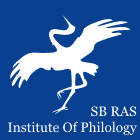 |
|
||||||||||||
|
Institute of Philology of
the Siberian Branch of Russian Academy of Sciences |
|
||||||||||||
|
|||||||||||||
|
DOI: 10.25205/2312-6337 Roskomnadzor certificate number Эл № ФС 77-84783
| |
| Yazyki i Fol’klor Korennykh Narodov Sibiri (Languages and Folklore of Indigenous Peoples of Siberia) | |
|
ArticleName: Functions of grass in ritual practice, folklore texts, and everyday life of Kamchatka Koryak-Nymylans Authors: T. A. Golovaneva Institute of Philology of the Siberian Branch RAS, Novosibirsk, Russian Federation In the section Фольклор: этнографический аспект
Abstract: This study focuses on the role of grass within the traditional Koryak-Nymylan culture. This research primarily employs a comparative-historical methodology, enabling analysis of folklore texts within their historical context and in relation to contemporaneous ethnographic and ritualistic practices. The interpretation of the Alutor lexicon was performed with the support of word-formation analysis. The Alutor language includes distinct terms for various grasses, such as lǝʕutaŋ grass (Cyperaceae), tǝwaju grass (Elymus mollis), and v’iʕe grass (Poa pratensis L.). In the traditional culture of the Nymylan, grass lǝʕutaŋ (Cyperaceae) was used during rituals. Lauten grass was believed to attract good luck and health. In Nynymylan mythological stories, the lǝʕutaŋ grass is mentioned as a means to protect oneself from evil spirits-niŋvit. Koryak-Nymylan narratives, unlike their ritualistic and mythological counterparts, feature a distinct species of grass: v’iʕe grass (Poa pratensis L.). In fairy tales, the v’iʕe grass is personified. Given that grass weaving was the exclusive domain of Nymylan women, the feminine essence of the grass characters in Koryak folklore is thus explained. The anthropomorphic nature of the v’iʕe grass as a mythological character is also manifested in riddles and beliefs. The Koryak-Nymylans used the tǝwaju grass (Leymus mollis) for weaving. Grass threads were used to weave mats and baskets. The traditional way of life, which has been lost by now, served as a basis for the formation of national folklore. Keywords: north-eastern Paleoasiates, Koryaks, nymylans, Chukotko-Kamchatsky languages, Alutor language Koryak folklore, Big Raven cycle, mythological beliefs, grass weaving, grass in Folklore Bibliography: Alfavitnyy spisok yazykov Rossii (s ukazaniem ikh geneticheskoy prinadlezhnosti) [Alphabetical list of languages of Russia (with indication of their genetic affiliation)]. In: Pis’mennye yazyki mira: Yazyki Rossiyskoy Federatsii. Sotsiolingvisticheskaya entsiklopediya. Kn. 1 [Written Languages of the World: Languages of the Russian Federation. Sociolinguistic Encyclopedia. Bk. 1]. V. M. Solntsev, V. Yu. Mikhal’chenko (Eds.). Moscow, Academia, 2000, p. XLVII. (In Russ.) Antropova V. V. Kul’tura i byt koryakov [Culture and life of the Koryaks]. Leningrad, Nau-ka, 1971, 216 p. (In Russ.) Burlak S. A., Starostin S. A. Sravnitel’no-istoricheskoe yazykoznanie [Historical and comparative linguistics]. Moscow, Academia, 2005, 432 p. (In Russ.) Jochelson W. The Koryak. Material Culture and social organization. The Jesup North Pacific Expedition. F. Boas (Ed.). Leiden, New York, 1908, vol. VI, 841 p. URL: http://www.kscnet.ru/ivs/bibl/kor/cont.htm (accessed: 01.02.2025). Jochelson W. I. Koryaki: Material’naya kul’tura i sotsial’naya organizatsiya [The Koryak: Material culture and social organization]. St. Petersburg, Nauka, 1997, 237 p. (in Russ.) Malyukovich V. N. Melodiya severnogo rassveta [The melody of the northern dawn]. S. V. Gavrilov (Comp.). Petropavlovsk-Kamchatskiy, Novaya kniga, 2023, 448 p. (In Russ.) Murav’eva I. A. Alyutorskiy yazyk kak predstavitel’ chukotsko-kamchatskoy sem’i yazykov [Alutor language as a representative of the Chukotka-Kamchatka language family]. In: Acta Linguistica Petropolitana. Trudy Instituta lingvisticheskikh issledovaniy RAN [Acta Linguistica Petropolitana. Transactions of the Institute for Linguistic Studies]. N. N. Kazansky (Ed.). St. Petersburg, Nauka, 2013, vol. IX, pt. 3, pp. 218–244. (In Russ.) Nagayama Yu., Nutayulgin V. M., Chechulina L. I. Nymylansko-russkiy slovar’: alyutorskiy dialect [Nymylan-Russian dictionary: Alutor dialect]. Yu. Nagayama (Ed.). Sapporo, 2019, pt. 2. (L–Ya). 140 p. (In Alutor and Russ.) Pletenie izdeliy iz rastitel’nykh materialov u koryakov [Weaving of products from plant materials among the Koryak people]. M. E. Belyaeva, A. A. Sorokin, S. S. Golikova (Comps.). Petropavlovsk-Kamchatskiy, Kamchatpress, 2018, 58 p. (In Russ.) Prytkova N. F. Odezhda chukchey, koryakov i itel’menov [Clothing of the Chukchi, Koryaks and Itelmens]. In: Material’naya kul’tura narodov Sibiri i Severa [Material culture of the peoples of Siberia and the North]. Leningrad, Nauka, 1976, pp. 5–88. (In Russ.) Tiron E. L. Mifologicheskie predstavleniya i fol’klor zimnego olenevodcheskogo prazdnika Pegyttyn koryakov-chavchuvenov [Mythological beliefs and folklore of the winter reindeer herders’ festival Pegyttyn of Koryaks-Chauchuvens]. Kunstkamera. 2023, no. 1 (iss. 19), pp. 55–74. (In Russ.) Vdovin I. S. Ocherki etnicheskoy istorii koryakov [Essays on the ethnic history of the Koryak people]. Leningrad, Nauka, 1973, 303 p. (In Russ.) |
 |
ИФЛ СО РАН 630090, Новосибирск, ул. Николаева, 8 тел./факс: 8-(383)330-15-18, ifl@philology.nsc.ru |
Карта сайта Дизайн © ИФЛ СО РАН |


